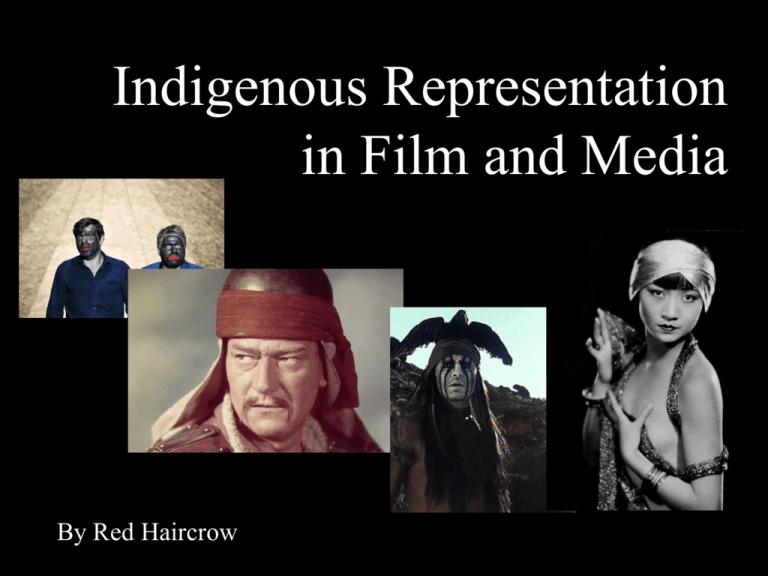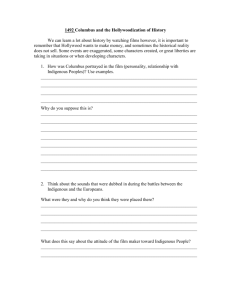Repräsentationen Indigener Im Film
advertisement

Indigenous Representation in Film and Media By Red Haircrow Overview Films can influence views on race and culture especially if different from their own or those they don’t know. Stereotypes and inaccurate history are more often believed if seen regularly. Acceptance of stereotypes has been proven to cause racism and discrimination. Aeta People of Phillipines (Docu) Inuit actor in film „Qallunaat“ So, it is even more important that different races and cultures present themselves in film so their cultures, traditions and beliefs may understood and treated with respect. But for indigenous peoples around the world, there can be many challenges to do so. Indigenous People Worldwide Facts and Statistics •370 million indigenous peoples in over 90 countries, making up one-third of the world’s poorest, suffering alarming conditions in all countries. Many have fractured societies resulting from forcible invasion and colonialism by Europeans. •Indigenous peoples all over the world continue to suffer from disproportionally high rates of poverty, health problems, violence, crime and human rights abuses. These are also aftereffects of colonization. Intercultural Understanding • The indigenous suffer the highest rates of systematic racism by majority population, violence, continued land grabs and environmental racism. They are most vulnerable to the effects of climate change, also as many are isolated and poor. • In whatever country they are, indigenous peoples’ life expectancy is up to 20 years lower than their non-indigenous counterparts. Education Complications More indigenous attend university than ever before but... • In societies like the US and Germany, where individualism and competition is encouraged, this is often opposite to indigenous ways that traditionally promote communal benevolence and cooperation. This means to succeed in German or US society can be spiritually and culturally hurtful for the indigenous, and can lead to loss or harm of native identity. Further • Suicide rates of indigenous peoples, particularly the youth, are considerably higher than other demographics. Even in countries considered to be the wealthiest in the world, like the US and Canada, suicide has reached epidemic proportions, where some natives are live in worse than third world conditions. Filmmaking Despite these challenges, limited resources, and fewer possibilities of distribution, in the last four decades more indigenous filmmakers are debunking stereotypes and giving truer representation of themselves. They show the indigenous in all their varieties. We see common daily life stories showing them as the human beings they are, not caricatures or stereotypes. Conversely, from the beginning of filmmaking, the majority of films on the indigenous were written, produced and directed by the non-indigenous people and based on racial bias and ignorance. Negative and incorrect stereotypes were standard over a hundred years ago, and not much has changed today. Examples of Stereotypes • 100 years ago and now, Australian aborigines are often presented as drunks, primitive, violent, devious and passive/aggressive. In America, it’s the same, but add the inevitable noble warrior, mystic shaman or exotic “Indian princess”. Despite raised awareness, statistics show such stereotypes draw the highest dollar amounts from non-indigenous audiences. • Another troubling factor, more evident in Germany and European countries, is that natives in film are almost always shown in past tense, as if natives are extinct or irrelevant today. Only their past image is recognizable or to be admired. For the Money... • Even when presenting stories involving minorities or ethnic characters, directors almost always having non-indigenous or white/European actors play non-white roles. The general consensus and fact is, despite controversy and challenge, the practice based on money: the majority of big-drawn actors are white and draw audiences and their money even when pretending to be other races. Prince of Persia (2010) Exodus Gods & Kings (2014) Key Factors of Misrepresentation (Films from the workshop description.) •Historical Inaccuracies (The White Comanche)—Changing the story to make Europeans more benevolent, loving, or heroes, while natives are more often made more vicious, cruel, and primitive. Cultural practices, clothing, languages and appearance are inaccurate. •Unethical Treatment (Green Inferno)—Specific misuse the indigenous tribe’s image and characteristics, failure to fully disclose storyline, gross negligence in intercultural contact. Part 2 • Romantization of Indigenous People or their Treatment (Pocahantas, The New World). The true acts of genocide, pillaging, widespread rape, cruelty and land theft by Europeans that took place across the world are conveniently “glossed over”. They are excused/mitigated by changing the narrative, by calling it progress, and/or the advance of civilization supporting the “Doctrine of Discovery” and “Manifest Destiny”. • Simplistic Characterizations & the Hero-izing of the White Man (New Winnetou, Ridiculous Six) While top natives roles are given to nonnatives, actual Aboriginal people are cast as support or kept in background, rarely allowed to speak or display their complexity and richness as human beings. Rarely is a Native permitted to tell his or her own story, and most stories are through the lens of the European perspective. Historical Inaccuracies (The White Comanche) • “The White Comanche” was released in 2014, debuting on SAT 1. It was first titled “The White Squaw”, already showing the company’s lack of knowledge. The film was written by a German author, and produced by Bilderfest. I was a consultant and casting agent as they wanted all native roles to go to natives. When they instead decided German Indian hobbyists, I declined any further participation. • Claimed to be a documentary based on Cynthia Ann Parker, a young German immigrant girl taken by Comanches in the 1800s. The actual event was documented, but very little other details or any information about her life among the Comanche. The only things know was she spent several years, became the wife of a native man and had three children before she was “rescued” by whites. She and her 5 year old daughter died soon after „liberation.“ Part 2 • Bilderfest's representative revealed to me that in their desire to make the story “entertaining” for its viewers, special “additions” would be made to spice it up. This is where I particularly feel they crossed the line into unethical and harmful misrepresentation. Ironic because this is supposed to be truth. A documentary. • Because they could not show the most extreme of their speculations and fabrications using humans, they used animations to show graphic violence and rape. For example, to represent what females, both native and captive may have to endure, one such “pictured a man and a woman having sex, the woman screaming in pain and crying while the man grunts and shouts triumphantly.” No history book or report, nor Cynthia herself said she had been raped. Part 3 •Other images show lots of screaming Indians and great splashes of blood as they slaughter terrified white people. All male Indians wore headdresses and sat around and had visions from peyote, or wildly danced. Women were docile, simply slaves and worth little except sex. •Parker’s descendants and other members of the tribe were outraged by this so-called documentary’s depiction of their people and continue to pursue legal restitution. An elder who had also been contacted for consultation before filming was too emotionally upset to further speak on the topic, especially when Bilderfest defended their film as just “entertainment.” Yet what they did cause real harm to the indigenous, their identity and contributes to negative stereotyping and racism. It also teaches children it is okay to cause cultural harm to others for their own satisfaction. Unethical Treatment (Green Inferno) • Eli Roth’s “The Green Inferno” released worldwide this year. It portrays a South American indigenous tribe as savage cannibals preying on white activists who come to defend the rain forests. The tribe is depicted as cannibals who practice female genital mutilation, both of which do not exist in the Amazon. • Like many other films, “A false stereotype of the animalistic and brutal indigenous savage is the central theme. Other than the fake name of the tribe, no indigenous person has a name in the film, says anything intelligible, nor is otherwise humanized.” Part 2 Though Roth’s film didn’t create the problem of illegal mining and violence against the Amazonians, and he claimed he was just trying to raise awareness of the problem, that certainly wasn’t the central theme, and “The Green Inferno” only reinforces existing prejudices against indigenous peoples, and makes on-going situations of discrimination, racism and ignorance worse. Part 3 •When confronted by native and human rights activists Eli Roth was very defiant and dismissive attitude toward native concerns and the film’s impact on natives as a whole and the tribe they used specifically. •Quoting Roth from an interview, he laughed saying: “We had to tell them what a movie is ... They've never even seen a television ... By the end they were all playing with iPhones and iPads. We've completely polluted the social system and fucked them up." Romanticizing of Natives & Their Treatment (The Pocahantas Story ) Pocahantas is one of Disney’s most beloved films yet is one of the most enduring and blatant examples of the romantization of natives, and particularly young females as “Indian Princesses” who inevitably falls in love with the handsome European explorer. It also involves a strong dose of historical inaccuracy and takes racist characterizations farther. •Her real name was Matoaka. •She was 10-12 years old when Europeans, including John Smith, contacted her tribe. •She was subjected to rape, abuse and was taken hostage. •She died of disease in her early 20s far from her homeland. Other Problems • “In the movies, Pocahontas disobeys her father and goes out to meet Captain John Smith. This most likely would not have happened during the time period in the movie, as it was a cultural norm for all tribal members to adhere to any strict directive from a parent.” • Both in Disney’s film and Malik’s The New World, Pocahantas was seen to be dressed briefly or in a possible sexually provocative way which is completely contrary to the modest dress typical of her tribe. Part 3 • Native women have the highest statistics of rape and domestic violence, by strong majority committed by non-native males. It is a huge problem. They, like Asian and African women have been sexualized and objectified by white filmmakers since filmmaking began. • Good Indian vs. Bad Indian. Pocahantas becomes a “good Indian” because she is made to appear to help Europeans. All Indians are bad, but there may be exceptions. If you don't help Europeans, you're bad. • Disney's version has a happy ending. Many Native Americans feel this is especially deceitful because that is exactly opposite to the real story, which was centuries of killings and oppression that still continue to this very day. Pocahantas‘s tribes was nearly wiped out by Europeans during that time period. No joyful dancing at all. Malik‘s The New World • Why are the actual facts changed by so many non-indigenous directors? • Why is the story changed to a gentle loving blending of cultures instead of the reality of the rape and murdering of the time period? Native Americans from all tribes find this deliberately falsehood deeply disrespectful and angering, and rightfully so. •I’ve focused most on Disney’s version, as Malik’s version follows this workshop, so then you’ll get to see another take on Pocahantas. Will his be a better portrayal, simply different or still problematic? Simplistic Characterization & Making White Man the Hero (Ridiculous Six, the new Winnetou) Fun At What Price? • Adam Sandler’s upcoming release is a parody of 1950’s and 60’s westerns, a comedy set in the “Old West” where inevitably Native Americans appeared. While there have been numerous such films in the past, some of which were criticized for their cultural insensitivity, since its 2015, supposedly a more enlightened time you’d think they’d do better. • Some native actors walked off the set, including the cultural advisor due to the disrespectful and demeaning characterization of elders and women, who were presented as being crude and primitive. Again, you have the stereotypical drunk Indians who’ll do anything for whiskey. Harmful Humor & Stereotyping • Cultural practices and traditions were a mish-mash of different tribes, and fun is made of native names, using sexist and sexually crude jokes. Though claiming it is only to be funny, they again reinforce negative, harmful stereotypes and inaccuracies. Like racist sport mascots, studies show this is psychologically damaging to natives, especially the young. • The reality is: Natives love comedy, and humor is often a very important part of indigenous life, but you don’t have to be racist and sexist to be funny. The New Winnetou But what of filmmakers who believe they are just telling a story, trying to make it authentic but also entertaining, showing the things they know their target audience want to see about natives? The upcoming film, the new Winnetou, would be such an example. Fotos Gala Zeitschrift More film location photos Apache Winnetou is a work of fiction, but the Apache people are not fiction. In 2015, filmmakers had the opportunity to make a culturally accurate film, but instead chose to reinforce wrong stereotypes, cast whites as natives, and misinform a new generation. –The new film has the Apache speaking Lakota. –Apache didn‘t live in tipis. –Apache didn‘t wear their hair in braids. –Apache women are very modest, and did not wear sexualizing garments. Traditional Apache female clothing Q: Why do such filmmakers believe it acceptable practice to change such details? 1. Privilege allows. 2.They‘re still supported. Indigenous Filmmakers Today Indigenous people in stereotypical roles continues to be a successful and lucrative formula for non-indigenous filmmakers. The indigenous are still more often "the bad guy", "the monster", "the criminal" "the drunk", "the comedy sidekick" and so forth. –But what is the solution? –Will activism help, will protesting such films? –Will more effort to help educate and raise awareness change these directors and writers’ minds? Sterlin Harjo World renown native writer and activist Sterlin Harjo said: “One actor in protest isn’t going to stop the millions of dollars behind films like these. A few people canceling their Netflix subscription or Disney studios isn’t going to stop them. What is going to stop it is when all of our actors turn down roles like this.... It’s going to stop when more indigenous filmmakers are supported to create their own visions. We have that power, we have the intelligence and creativity but we need support. Right now, in America, Native filmmakers are on the outskirts of the outskirts – it’s true independent cinema. Studios won’t touch us. Indians in buckskin and feathers is the only way studios want to see us because it fits their narrative. They don’t want to see the truth.” Everyday You can support indigenous films and indigenous filmmakers as allies by continuing a respectful and understanding education on both the challenges and beauty of indigenous people, their cultures, histories and traditions and their relevance and worth in a world in which they are also a part. Control of Identity It is critically important indigenous peoples control their own public images, and show their lives and histories in an honest way, not the imagination or speculation of the non-indigenous. Indigenous Directors This is only a few, but more and more indigenous directors and writers are telling their own stories. Leena Manimekalai (Tamil) Mitch Torres (Aboriginal Australian) Taika Waititi (Maori) Solbon Lygdenov (Buryat) Ruben Reyes (Garifuna) Mark Smith (Choctaw) Native Boy Productions More Films By or About Indigenous The 1st Maori Language Action Film (2015) Based on a true story, By the Yakel people of Vanuatu (2015) Film Genres beyond the traditional: „Violet“ –A Thriller/Horror Film (2014) Traditional Mongolian Challenged by Urbanization (2005) „Polyglot“, by Rwandan Berliner Amelia Umuhire. The life of a ex-pat of color in Berlin. (2015) Select Bibliography 1. THE PERPETUATION OF NATIVE STEREOTYPES IN FILM By KIMBERLEY KIYAWASEW. (January, 2014). http://dtpr.lib.athabascau.ca/action/download.php?filename=mais/700/Kiyawasew%20Final%20Project.pdf 2. Media Smarts (2015) Common Portrayals of Aboriginal People http://mediasmarts.ca/diversity-media/aboriginal-people/common-portrayals-aboriginal-people. 3. "The Green Inferno" – Even Worse Than We Anticipated. September 25, 2015 Andrew E. Miller http://amazonwatch.org/news/2015/0925-the-green-inferno-even-worse-than-we-anticipated 4. 'The Green Inferno' Review: Lousy Film, Plenty Racist by Tara Houska. 10/2/15 Read more at http://indiancountrytodaymedianetwork.com/2015/10/02/green-inferno-review-lousy-film-plenty-racist-161947 5. The Pocahontas Paradox: A Cautionary Tale for Educators. Cornel Pewewardy, Ph.D. http://www.hanksville.org/storytellers/pewe/writing/Pocahontas.html 6. Pocahantas, Veronia Nunez, 2009, http://disneyandmovies.pbworks.com/w/page/17905676/1%20Pocahontas. 7. The Story About Adam Sandler's 'Ridiculous Six' You Didn’t Hear: Four Natives Speak. ICTMN Staff. 6/4/15 Read more at http://indiancountrytodaymedianetwork.com/2015/06/04/story-about-adam-sandlers-ridiculous-six-you-didnt-hear-four-natives-speak-160612 8. Read a Page From the Adam Sandler Script That Caused Native Actors to Quit by Vincent Schilling. 4/24/15. Read more at http://indiancountrytodaymedianetwork.com/2015/04/24/read-page-adam-sandler-script-caused-native-actors-quit-160135 9. Netflix and Adam Sandler’s Ridiculous Six by Lauren Wissot. May 14, 2015. 10. SHAME ON HOLLYWOOD: These Are The Most Racist Films Of All Time by Keertana Sastry. Jun. 1, 2012. http://www.businessinsider.com/the-mostracist-films-of-all-time-2012-5?op=1&IR=T 11. UN State of the Indigenous Peoples Report http://www.un.org/esa/socdev/unpfii/documents/SOWIP/press%20package/sowip-press-package-en.pdf 10. Shier, Sarah (2006). THE DEPICTION OF INDIGENOUS AFRICAN CULTURES AS OTHER IN CONTEMPORARY, WESTERN NATURAL HISTORY FILM. http://citeseerx.ist.psu.edu/viewdoc/download?doi=10.1.1.509.646&rep=rep1&type=pdf 11. The Making of Buryatian history: Solbon Lygdenov. At http://calvertjournal.com/articles/show/1381/the-making-of-the-buryatian-film-industry. All photos are copyright to their respective owners. No copyright infringement is intended. For educational purposes only.






